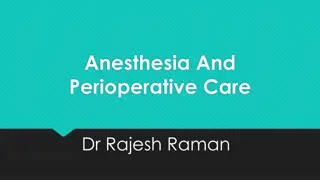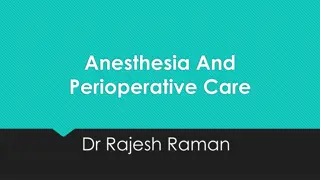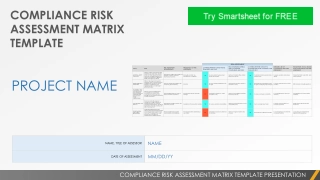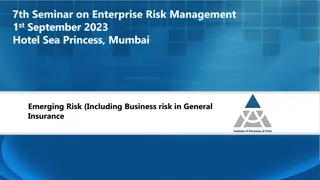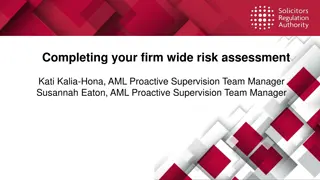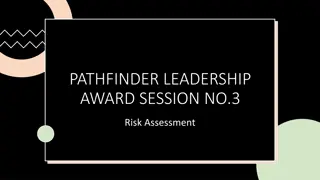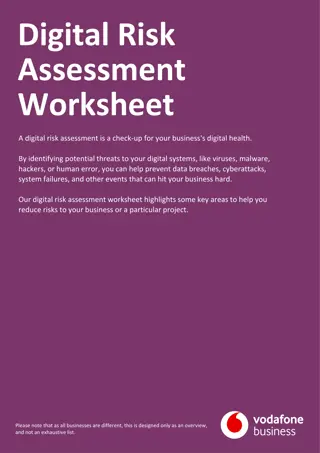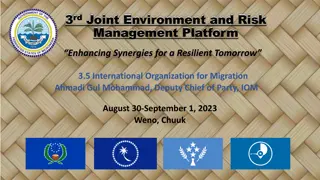Comprehensive Overview of Reverse Osmosis (Desalination) Treatment and Risk Assessment Training 2018
Reverse Osmosis (RO) treatment is an effective but not commonly used method, suitable for challenging situations where other treatments may not work. It removes various contaminants and requires pre-treatment and remineralization. RO systems need careful maintenance and monitoring to prevent fouling and damage, highlighting key points to watch for during installation and operation.
Download Presentation
Please find below an Image/Link to download the presentation.
The content on the website is provided AS IS for your information and personal use only. It may not be sold, licensed, or shared on other websites without obtaining consent from the author. Download presentation by click this link. If you encounter any issues during the download, it is possible that the publisher has removed the file from their server.
Presentation Transcript
Treatment Reverse Osmosis (Desalination) DWQR Risk Assessment Training 2018
Overview Not that common OTT for most PWS but OK for difficult to treat situations Removes almost everything from water MUST have pre-treatment and Remineralisation Not a cheap option Osmosis water passes from weaker solution to more concentrated Can be made to flow in opposite direction (RO) across membrane by applying pressure Produces almost pure water plus concentrated waste stream Can be point of use Significant purchase and running cost
Usage 1 Situations where nothing else will work Often mineral / chemical contamination ( As, B, Pb, Cd, Cr, Cu, Sb ) Also removes pathogens providing there is no re-contamination Should remove colour-causing organic compounds
Usage 2 Several stages of pre-treatment needed to prevent RO fouling Pre-treatment filters often built into unit. Are they sufficient? Water CANNOT be drunk straight from RO must be remineralised RO water is corrosive to pipework (and humans!) Membranes may be cleaned (for PWS usually replaced running cost)
Key Points to Watch For May be installed as an over the top solution by inexperienced engineers Maintenance programme for replacement of filters & re- mineralisation Are all taps in property covered (often under sink solution ) How do you know the membrane has not been breached? (monitor for contaminant) If flow dropping, membrane may be fouling or scaling Is the concentrate being disposed of properly?
Questions Hazard Type Location Risk No.Potential Risk Explanation of Hazard Severity Installation and Operation Treatment TRO1 Is RO (Reverse Osmosis) plant specification/ design inadequate for raw water quality? The water quality challenges should be clearly understood and the membrane selected should be appropriate to water quality in a range of conditions. 5 Installation and Operation Treatment TRO2 Could pre-treatment be inadequate, resulting in RO fouling and damage (such as inadequate removal of oxidants)? RO membranes require clean water at the inlet. In almost all cases comprehensive pre-treatment will be required to ensure water meets the specification. Inadequate pre-treatment will result in fouling of the membrane and, potentially, lasting damage. 4 Installation and Operation Treatment TRO3 Is there a risk from inadequate re- mineralisation of the water following RO? Re-mineralisation is vital after RO as the water has been stripped of minerals and is very corrosive. This step should be incorporated in plant design and any equipment maintained in accordance with the manufacturer's specifications. 3 Management and Management and Resilience Treatment TRO4 Are the cleaning regimes (for descaling and antifouling, etc.) inadequate or undocumented? Membranes require a specific cleaning regime at regular intervals. Care should be taken that the manufacturer's specifications are followed and the correct procedures and chemicals used. 5 Management and Management and Resilience Treatment TRO5 Are the chemicals used in the process incorrect or stored incorrectly? Many membrane cleaning chemicals are acids or alkalis and require specific storage conditions to ensure that they remain effective and are in a safe condition. 4 Installation and Operation Treatment TRO6 Could a loss of membrane integrity go undetected? If the membrane is breached it will not provide a reliable barrier. How would this be picked up? Some membranes have integral automatic detection systems, but other systems may rely on monitoring or sampling. The appropriate integrity monitoring system will depend on the type of membrane and water quality - specialist advice should be sought. 5 Installation and Operation Treatment TR07 Could failures occur due to membranes not being replaced as per the manufacturer's specifications? The manufacturer will specify the frequency at which the filters should be replaced. Ask for evidence that this is being adhered to. Membrane elements need to be handled with care and manufacturers' specifications should be followed closely. 5








